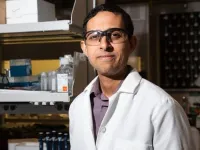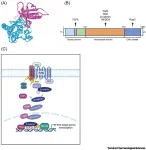(Press-News.org) Music and speech are among the most frequent types of sounds we hear. But how do we identify what we think are differences between the two?
An international team of researchers mapped out this process through a series of experiments—yielding insights that offer a potential means to optimize therapeutic programs that use music to regain the ability to speak in addressing aphasia. This language disorder afflicts more than 1 in 300 Americans each year, including Wendy Williams and Bruce Willis.
“Although music and speech are different in many ways, ranging from pitch to timbre to sound texture, our results show that the auditory system uses strikingly simple acoustic parameters to distinguish music and speech,” explains Andrew Chang, a postdoctoral fellow in New York University’s Department of Psychology and the lead author of the paper, which appears in the journal PLOS Biology. “Overall, slower and steady sound clips of mere noise sound more like music while the faster and irregular clips sound more like speech.”
Scientists gauge the rate of signals by precise units of measurement: Hertz (Hz). A larger number of Hz means a greater number of occurrences (or cycles) per second than a lower number. For instance, people typically walk at a pace of 1.5 to 2 steps per second, which is 1.5-2 Hz. The beat of Stevie Wonder’s 1972 hit “Superstition” is approximately 1.6 Hz, while Anna Karina’s 1967 smash “Roller Girl” clocks in at 2 Hz. Speech, in contrast, is typically two to three times faster than that at 4-5 Hz.
It has been well documented that a song’s volume, or loudness, over time—what’s known as “amplitude modulation”—is relatively steady at 1-2 Hz. By contrast, the amplitude modulation of speech is typically 4-5 Hz, meaning its volume changes frequently.
Despite the ubiquity and familiarity of music and speech, scientists previously lacked clear understanding of how we effortlessly and automatically identify a sound as music or speech.
To better understand this process in their PLOS Biology study, Chang and colleagues conducted a series of four experiments in which more than 300 participants listened to a series of audio segments of synthesized music- and speech-like noise of various amplitude modulation speeds and regularity.
The audio noise clips allowed only the detection of volume and speed. The participants were asked to judge whether these ambiguous noise clips, which they were told were noise-masked music or speech, sounded like music or speech. Observing the pattern of participants sorting hundreds of noise clips as either music or speech revealed how much each speed and/or regularity feature affected their judgment between music and speech. It is the auditory version of “seeing faces in the cloud,” the scientists conclude: If there’s a certain feature in the soundwave that matches listeners’ idea of how music or speech should be, even a white noise clip can sound like music or speech. Examples of both music and speech may be downloaded from the research page.
The results showed that our auditory system uses surprisingly simple and basic acoustic parameters to distinguish music and speech: to participants, clips with slower rates (<2Hz) and more regular amplitude modulation sounded more like music, while clips with higher rates (~4Hz) and more irregular amplitude modulation sounded more like speech.
Knowing how the human brain differentiates between music and speech can potentially benefit people with auditory or language disorders such as aphasia, the authors note. Melodic intonation therapy, for instance, is a promising approach to train people with aphasia to sing what they want to say, using their intact “musical mechanisms” to bypass damaged speech mechanisms. Therefore, knowing what makes music and speech similar or distinct in the brain can help design more effective rehabilitation programs.
The paper’s other authors were Xiangbin Teng of Chinese University of Hong Kong, M. Florencia Assaneo of National Autonomous University of Mexico (UNAM), and David Poeppel, a professor in NYU’s Department of Psychology and managing director of the Ernst Strüngmann Institute for Neuroscience in Frankfurt, Germany.
The research was supported by a grant from the National Institute on Deafness and Other Communication Disorders, part of the National Institutes of Health (F32DC018205), and Leon Levy Scholarships in Neuroscience.
# # #
END
Is it a sound of music…or of speech? Scientists uncover how our brains try to tell the difference
Slow and steady waves sound like music while faster and irregular ones like speech
2024-05-28
ELSE PRESS RELEASES FROM THIS DATE:
New test rapidly diagnoses Toxoplasma infections and reduces false positives
2024-05-28
An inexpensive, accurate test that detects infections with the parasite Toxoplasma gondii can provide results within 30 minutes from a finger-prick in a doctor’s office or within an hour from a small blood sample tested in a local medical laboratory. The new test can also identify false positives in other types of commercial diagnostic tests for toxoplasmosis, providing swift reassurance to uninfected pregnant women and their doctors and facilitating timely interventions to protect a fetus against toxoplasmosis in acutely infected pregnant mothers.
These findings appear in a study, led by toxoplasmosis specialist Rima McLeod, MD, ...
Overlooked lipid connected to ancient cellular pathway with links to cancer
2024-05-28
Within the family of cell membrane lipids known as phosphoinositides and the kinase enzymes that regulate them, phosphoinositide 3-kinases (PI3Ks) have been cast in a starring role as scientists study their involvement in cancer, diabetes and many cellular activities.
The presence of PI3Ks in the scientific limelight has overshadowed other members of this lipid enzyme family, including phosphatidylinositol-5-phosphate 4-kinases (PI5P4Ks). Brooke Emerling, Ph.D., co-director of, and associate professor in, the Cancer Metabolism and Microenvironment Program at Sanford Burnham Prebys, is contributing to a revival of interest in this underappreciated set of enzymes.
Emerling and team have ...
Text reminders help connect health care workers to care and improve their mental health
2024-05-28
Health care workers have reported spikes in feeling burnt out in the time since the COVID-19 pandemic began, with nearly half saying it took a toll in 2022 compared to 32 percent in 2018. But a new study shows that easy-to-use and accessible platforms may help reverse this trend. Regular, automated text message reminders connecting staff to a mental health platform called “Cobalt,” drove significant improvements in both depression and anxiety scores among employees, according to a new JAMA Network Open study from the Perelman School of Medicine at the University of Pennsylvania.
“What we found shows ...
Optimal cancer-killing t cells discovered
2024-05-28
A team of cancer researchers, led by the University of Houston, has discovered a new subset of T cells that may improve the outcome for patients treated with T-cell therapies.
T cell-based immunotherapy has tremendous value to fight, and often eliminate, cancer. The strategy activates a patient’s immune system and engineers a patient’s own T cells to recognize, attack and kill cancer cells. In this way, the body’s own T cells become living drugs.
While T-cell immunotherapy has revolutionized cancer treatment, there is still much to learn. Unfortunately, not all patients ...
Wind farms are cheaper than you think – and could have prevented Fukushima, says global review
2024-05-28
Offshore wind could have prevented the Fukushima disaster, according to a review of wind energy led by the University of Surrey.
The researchers found that offshore turbines could have averted the 2011 nuclear disaster in Japan by keeping the cooling systems running and avoiding meltdown. The team also found that wind farms are not as vulnerable to earthquakes.
Suby Bhattacharya, Professor of Geomechanics at the University of Surrey’s Department of Civil and Environmental Engineering, said:
“Wind power gives us plentiful clean energy – now we know that it could also make other facilities safer and more reliable. The global review finds ...
Improved refrigeration could save nearly half of the 1.3 billion tons of food wasted each year globally
2024-05-28
May 28, 2024
Contact: Jim Erickson, 734-647-1842, ericksn@umich.edu
Graphic
Improved refrigeration could save nearly half of the 1.3 billion tons of food wasted each year globally
ANN ARBOR—About a third of the food produced globally each year goes to waste, while approximately 800 million people suffer from hunger, according to the U.N.'s Food and Agriculture Organization.
A new University of Michigan study concludes that nearly half of the food waste, about 620 million metric tons, could be eliminated by fully refrigerated food supply chains worldwide.
At the same time, ...
From fibrosis and cancer to obesity, Alzheimer’s and aging: New paper reveals broad potential of TNIK as a therapeutic target
2024-05-28
A new paper in Trends in Pharmacological Sciences from researchers at generative artificial intelligence (AI)- and robotics-powered clinical stage drug discovery company Insilico Medicine (“Insilico”) and ETH Zurich reveals the broad potential of TNIK as a therapeutic target for some of the most pervasive aging-related diseases, including fibrosis, cancer, obesity, and Alzheimer’s. The findings could guide the development of new therapeutics. The lead drug in Insilico’s pipeline, INS018_055, is an AI-designed TNIK inhibitor being advanced as a treatment ...
Finnish Vole fever spreading further south
2024-05-28
Researchers have discovered that bank voles in southern Sweden (Skåne) carry a virus that can cause hemorrhagic fever in humans. This finding was made more than 500 km south of the previously known range. The virus strain discovered in Skåne appears to be more closely related to strains from Finland and Karelia than to the variants found in northern Sweden and Denmark. This is revealed in a new study from Uppsala University, conducted in collaboration with infectious diseases doctors in Kristianstad and published ...
Prenatal exposure to air pollution associated with increased mental health risks
2024-05-28
A baby’s exposure to air pollution while in the womb is associated with the development of certain mental health problems once the infant reaches adolescence, new research has found. The University of Bristol-led study, published in JAMA Network Open today [28 May], examined the long-term mental health impact of early-life exposure to air and noise pollution.
Growing evidence suggests air pollution, which comprises toxic gases and particulate matter, might contribute to the onset of mental health problems. It is thought that pollution could negatively affect mental health via numerous ...
New research supports expansion of kidney donation to include organs from deceased patients who once had dialysis
2024-05-28
Researchers from Johns Hopkins Medicine propose a novel approach to addressing the pressing issue of a kidney donor shortage through findings that suggest a promising method to expand the pool of available kidney donors by utilizing deceased donors on dialysis for kidney transplants.
The findings, published in the May 23rd issue of JAMA, identifies that while those who received such kidneys experienced a “significant delay” in the function of the transplanted organ compared to those ...
LAST 30 PRESS RELEASES:
New camera traps snap nearly three times more images of endangered Sumatran tigers than before
Survey: Nearly all Americans not aware midwives provide care beyond pregnancy, birth
Fearless frogs feast on deadly hornets
Fibulin-5: A potential marker for liver fibrosis detection
Development of 'OCTOID,' a soft robot that changes color and moves like an octopus
Marriage, emotional support may protect against obesity through brain-gut connection, study finds
High-speed all-optical neural networks empowered spatiotemporal mode multiplexing
High-energy-density barocaloric material could enable smaller, lighter solid-state cooling devices
Progresses on damped wave equations: Multi-wave Stability from partially degenerate flux
First discoveries from new Subaru Telescope program
Ultrafast laser shock straining in chiral chain 2D materials: Mold topology‑controlled anisotropic deformation
Socially aware AI helps autonomous vehicles weave through crowds without collisions
KAIST unveils cause of performance degradation in electric vehicle high-nickel batteries: "added with good intentions
New ECU tool can help concussion patients manage fear and improve recovery
People with diabetes face higher risk of sudden cardiac death
Breast density notification increases levels of confusion and anxiousness among women
K’gari’s world famous lakes could be at risk of drying
Airplane and hospital air is cleaner than you might think
Concern over harmful medical advice from social media influencers
Telling women as part of mammography screening that they have dense breasts may have unintended effects
Note- taking alone or combined with large language models helps students understand and remember better than large language models alone
Astronomers spot one of the largest spinning structures ever found in the Universe
Retinal organoid platform identifies biomarkers and affords genetic testing for retinal disease
New roadmap reveals how everyday chemicals and microbes interact to fuel antimicrobial resistance
Scientists clarify how much metal in soil is “too much” for people and the environment
Breakthrough pediatric kidney therapy emerges from U. Iowa research
Breakthrough iron-based magnetic material achieves major reduction in core loss
New design tackles heat challenges in high-power fiber lasers
Rapid fabrication of self-propelled, steerable magnetic microcatheters for precision medicine
Poor kidney health linked to higher levels of Alzheimer’s biomarkers in blood
[Press-News.org] Is it a sound of music…or of speech? Scientists uncover how our brains try to tell the differenceSlow and steady waves sound like music while faster and irregular ones like speech



